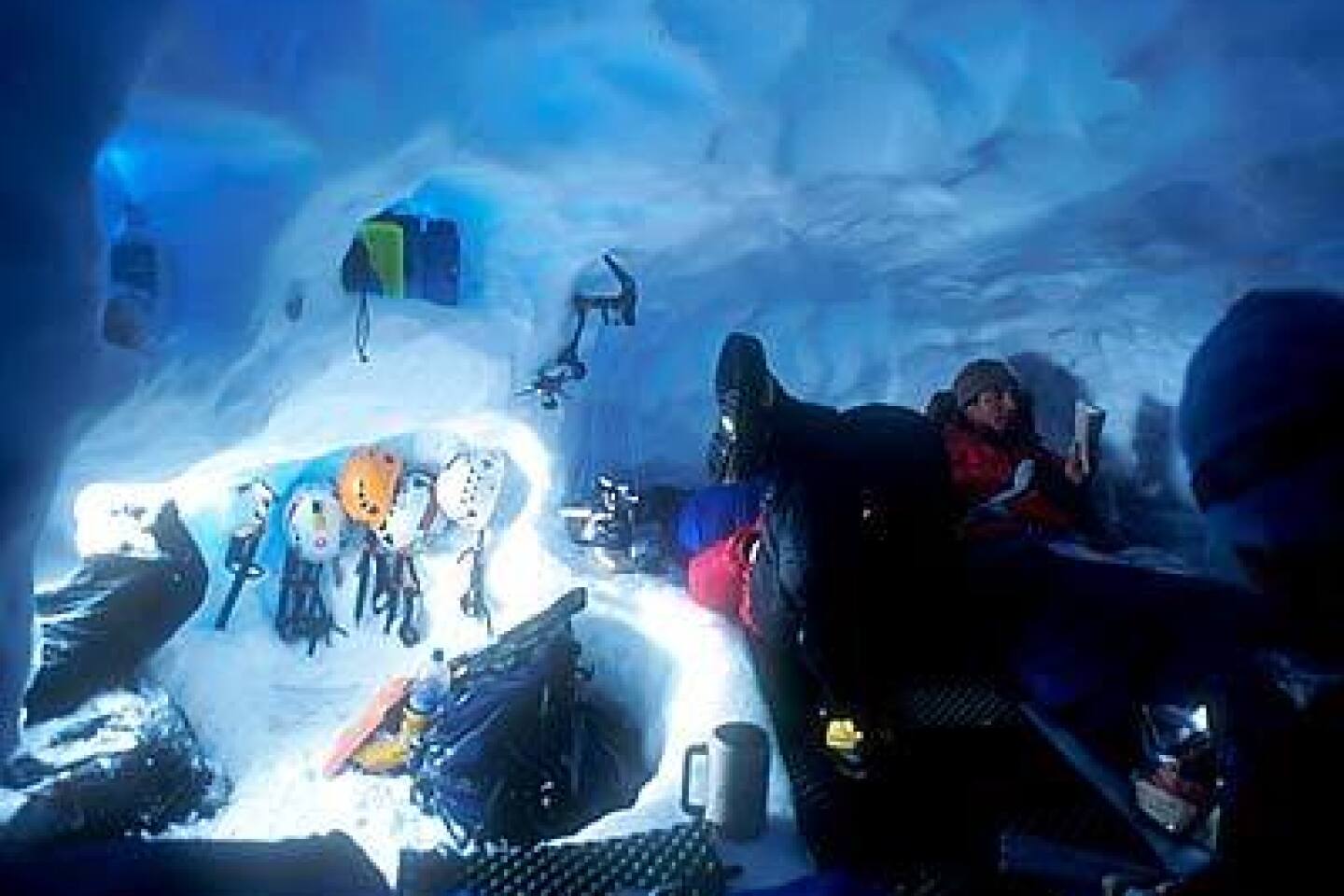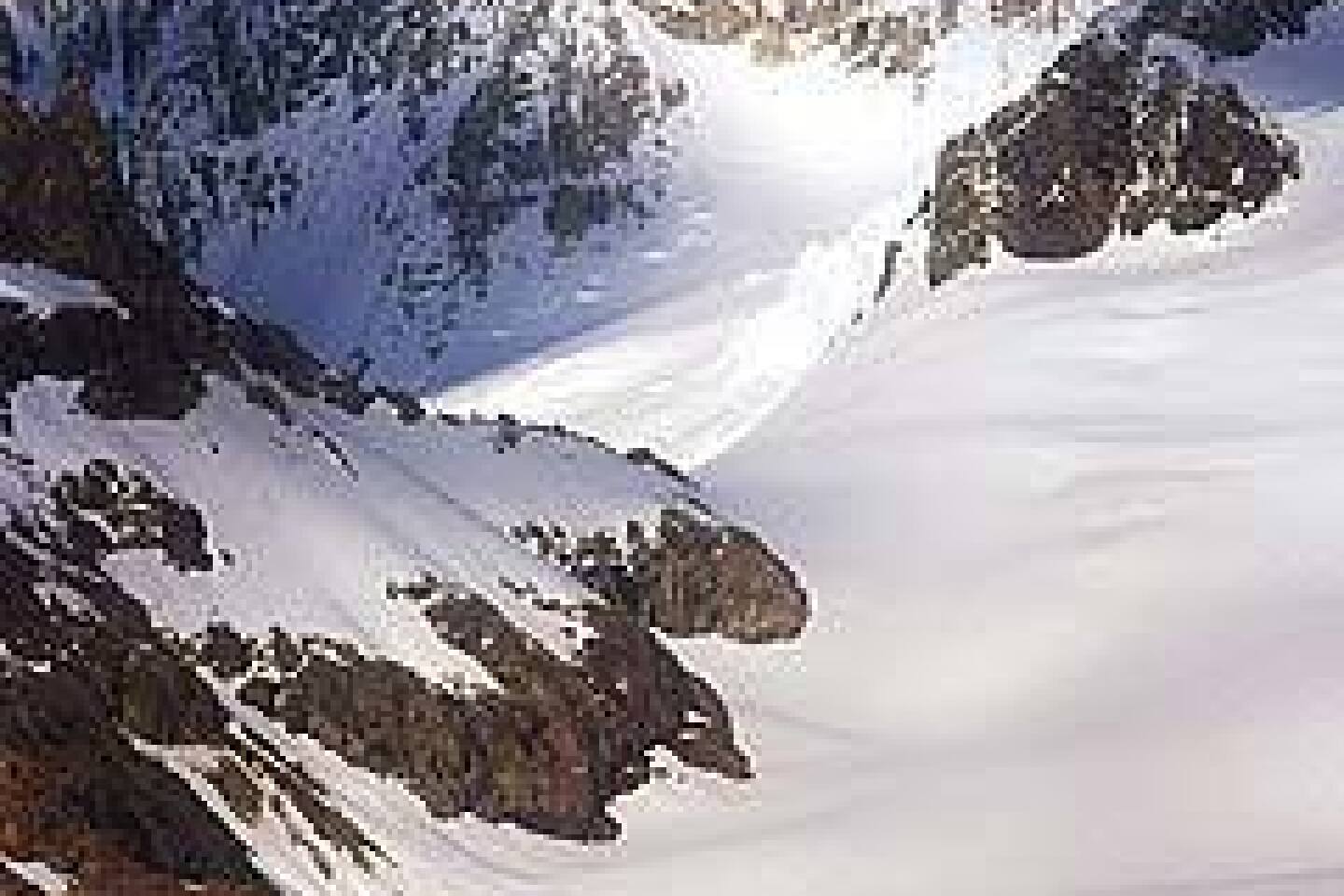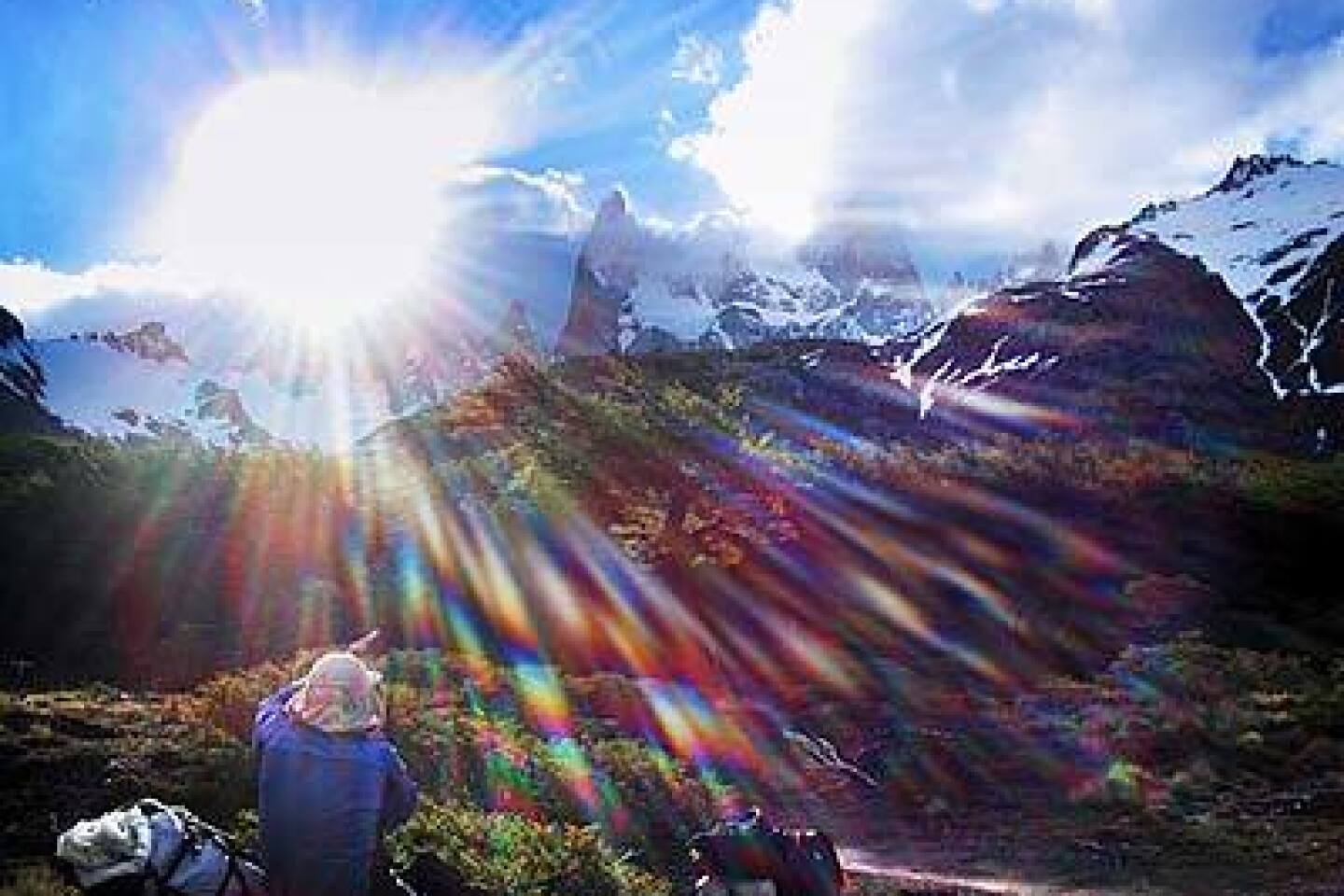Saving face with Fitzroy
There is a saying at the bottom of the world that, if you want to experience all four seasons in Patagonia, you have to spend the day.
I have already spent several years by that yardstick holed up in the windsocks that pass for tents here. I’ve been waiting for a break in the blitzing skies for a rematch with Mt. Fitzroy, a monolith of stone and ice whose jagged profile is an emblem of vertical adventure. The tallest mountain in the Patagonian Andes, Fitzroy is known for its towering face, which is one of the pinnacles of rock climbing. Over the last 30 years this mountain has been my ecstasy — and agony. When I was 20, exultation and tragedy combined in a rite of passage that shaped my life. Now, at 50, I am back. And wondering if I’m not delusional to be here.
Rising in sheer audacity at the southernmost tip of the Andes astride the Patagonian Ice Cap, Mt. Fitzroy — named for Robert Fitzroy, captain of the HMS Beagle — is so well-defended by notorious walls and storms that fewer have stood on its 11,070-foot summit through history than on the top of Mt. Everest in a single day. Most climbers are battered into submission, many are injured, and more than a few have died.
Buffeted in my tent at base camp, I can only wait and wonder about what Fitzroy and the elements have in store for us when we are clinging to the peak’s exposed wall. The trouble is, I know all too well.
In 1973, Fitzroy had been climbed only a handful of times, our route but once. We were seven fledgling mountaineers in our 20s for whom the summit of Fitzroy was a prize beyond measure — worth risking it all. We called our team the Freaker’s Ball after the music that blasted from the tape deck of our ancient Ford truck. Four would make the ultimate ascent: David Kilcullen and Kevin Carroll from New Zealand, Steve McAndrews — my best buddy — and me from the States.
McAndrews and I taught kayaking and rock climbing together in the summers. The year before, after an aborted traverse of the Patagonian Ice Cap on skis, we had been stranded on an outback Argentine ranch for three months while our parents and friends wondered if we were alive. While McAndrews spent his teenage years in Texas riding, roping and being tossed on top of wild bulls, I had grown up in New Jersey, sneaking into concerts at the Fillmore East and attending love-ins. Outwardly, we couldn’t have been more different. What we shared was climbing, a love of mountains and a deep friendship. On the rock there was no one I would rather have on the other end of my rope, no one sturdier or more capable than McAndrews.
In your 20s you don’t ask why. You simply do it. Fitzroy was to be “the big one.” Unconsciously we believed its summit would be the great hunt from which we would return, trophy in hand, to be hailed as warriors. But, as we would learn, to return at all would be the challenge.
*
Excuses exhausted
Three decades had passed, and I had never exorcised the demons of that climb. The man at 50 still remembered the moment that McAndrews had turned to the boy of 20 and said, “You didn’t really train for this, did you? You are not really ready, are you?” And still they climbed on. Still his friend had tied on to his rope, put his life in his hands. The man remembered the fear and regret he had felt at 20 during and after that climb. It still haunted him.Then one day a friend asked me what was left unfinished in my life as I approached the mid-century mark. I said one word: Fitzroy.
“So why not go?” he asked.
The excuses were endless. Job. Age. Extra baggage above the belt. Climbing skills that had atrophied. Kids! How could I risk Fitzroy with kids? But then I felt it: the adrenaline rising, the surge of power in my step, the sudden tang of the cold air in my lungs. What if I decided at 50 to get into the best shape of my life, to truly step back into the life of adventure?
Over a year and a half of training, I regained forgotten snow-and-ice techniques and honed my rock skills, climbing almost daily. I even managed to make it to the top of Yosemite’s Half Dome — a single, grueling, 12-hour day. I was fueled by the greatest motivator: fear. This time I knew what I was up against — and that, no matter the outcome, there would be no room on this expedition for someone to say: “You didn’t really train for this, did you?”
I’m encouraged by my team, stocked with wilderness pros Miles Smart, Mark Newcomb and Kris Erickson; longtime adventure partner and instigator of this campaign Stephen Meyers; and Patagonian legend Bean Bowers, who has summitted Fitzroy as well as most of the area’s other major peaks.
But no matter how strong the team is, it’s the weather that will decide our fate. Storms surge so fast off the Pacific and across the ice cap that the most glorious day can become a gale-lashed battle zone in a blink. The round trip from advance base camp to the summit of Fitzroy will require a day and a half of nonstop climbing. Exposed on the pinnacle in a storm, we would have little chance of making it back. I heard about a young climber named Franky, who had appeared on the local scene a couple of years ago and became everyone’s favorite.
“Too bad about Franky,” I was told.
“Why too bad?” I asked.
“A storm hit him on the way down. He’s still hanging up there. Like a Christmas ornament.”
*
Face to face
Thirty years ago, Franky could have been any one of us. The Kiwis, McAndrews and I had loaded up ropes and axes, strapped on our crampons, and headed up the Super Canaleta, a deceptively straightforward-looking route on Fitzroy’s west side. We had food and fuel for three days. Overconfident and armed with bad information, we started up the long granite face to the summit. Flushed by adrenaline and focused on handholds, footholds and ice screws, we didn’t notice the hours passing like minutes.It wasn’t until our third night’s hanging bivouac that reality dawned. We were not going to make it if we kept on climbing as a team of four. Three days had been allotted for ascent and descent. It was day four, and we were still headed up. Food and propane were nearly gone. We agreed that only the best among us should continue. McAndrews, who had been doing most of the leads, would climb for the Americans. Carroll would represent the Kiwis.
Only a few hundred yards beneath the summit, McAndrews and I embraced, and I wished him the best. With a final tap, I snugged the first pin, and began to rappel down the cliff face. I looked up and saw McAndrews vanish into a cloud that seemed to have appeared from nowhere.
After McAndrews ascended into the cloud, I never saw him — or Carroll — alive again. No one will ever know what happened or whether they made the summit. Somehow that ceased to matter the moment we found the bodies. Wrapped in ropes, it appeared they had fallen a long way. What mattered was that I had lost my friends, one of them my very best. The next 30 years of my life were imprinted with that loss.
*
Rapture dance
At base camp, the waiting drags on. A chill settles into our bones. The wind roars even into dreams. Time and time again I awake to wonder whether this would be the gale that uprooted the entire forest and sent tents like giant box kites, occupants and all, hurtling skyward. Days pass in my nylon cocoon.There is plenty of time to think about the illogic of what I am doing here. Climbing legend Eric Shipton called this range of knife-edged towers the “fatal lodestone.” It is a kind of madness. To risk one’s existence and face extremes of exertion and discomfort, to spend your entire life savings in the mere hope of standing for a matter of moments atop an icy rock is not logical. But then again, neither is life. There is no reason for life, no answer to the question of life other than more life!
As D.H. Lawrence wrote, “For man, the vast marvel is to be alive. For man, as for flower and beast and bird, the supreme triumph is to be most vividly, most perfectly alive . We ought to dance with rapture that we should be alive and in the flesh, and part of the living, incarnate cosmos.”
In simplest terms, what appears to the flatlander as a death wish is actually its polar opposite. It is a life wish. To choose a life of risk and danger is to forcefully shake my somnambulant self by the shoulders and say: “Come alive, you slacker. This is the magical existence you have been given. Wake up!” There may be myriad ways to find this awakened state. But those of us who truly love the mountains often know but this one. And why Patagonia? Because here, with the screaming wind, ice-draped towers and thundering avalanches, it is difficult to fall back to sleep.
After midnight one morning I hear a voice outside the tent. The angry wind has subsided, the sky is clear. We are going. Navigating across a frozen landscape by the dim glow of my headlamp, I trudge upward through this eerie, lonely world. Six hours later, atop the Paso Superior Glacier, we excavate our snow cave. Hopes rise, only to be dashed by storm clouds. We have to head down again. And again, four times over the next few weeks. In the course of this yo-yo, a British team that is dug into a snow cave next to us runs out of time and calls their expedition quits.
The frustration and pressure grows as our remaining time dwindles to a few days. It seems futile.
But then we get a weather report from the Chilean navy. A window of good weather is headed our way. It coincides with the final days of the expedition.
This is it. The first hours are still and starlit. Clinging to hand lines by the dim light of our headlamps, we struggle through deep snow, skirting freshly opened crevasses on the glacier. We arrive at our snow cave late in the morning and start preparing the assault. We break a hole into the adjoining cave of the British team that turned back and find ourselves in palatial frozen digs, which we dub Palacio Superior. The sky is blue and stunningly cloudless. There is no wind.
Sometime after midnight, we make our push, climbing toward the ice-guarded base of Fitzroy. But by the time we reach the foot of Brecha de Los Italianos, a col high up on the route, the clouds have swarmed once more. Now the climb begins in earnest. Two pitches of steep snow-climbing lead to a mixture of crumbly rock and see-through ice leading to the top of the ridge.
I plant the pick of one ice hammer, then the other. Each move means balancing delicately, pulling up into space, trusting an eighth of an inch of ice to hold my weight, while beneath my boots swirl thousands of feet of emptiness.
Suddenly, the ice beneath the hammer in my right hand gives way. The jolt shakes loose my left foot, then my right. In an adrenalized instant I realize all that holds me to the mountain are a few teeth on an ice hammer. Instinctively, my feet shoot out in both directions. Flailing, hoping.
A single front point lodges momentarily in the brittle ice.
With a desperate stab, I plant my right hammer.
It holds.
I’m able to place my feet and calm my jumping heart.
We traverse to a col where Bean and Kris are preparing, not to go up, but to descend back down the glacier. “It’s over. We’ve got to go down,” declares Bean over the howl of the icy wind.
I want to go on to cross the Silla — the snow cornice that leads to the base where the steep rock begins — but both Kris and Bean say it is too dangerous. The elements have turned against us again. We are screaming at the top of our lungs simply to be heard.
“What do you think, Miles. Are you up for it?” I yell. “Sure. Why not? It seems reasonable to me ” he shouts.
Mark joins us too. We know we are tempting fate. Yet it seems symbolically important to make the top of the Silla, to look up at the 10 pitches that would have taken us to the summit ridge and touch the rock. We say nothing but move quickly, knowing we are risking the wrath of the gods while asking for leniency. A few inches of snow conceal the slickest, clearest ice imaginable. We rope up, clinging to the rock, knowing that any overconfidence will end in a long flight down.
The clouds are back to their usual fury. A legend of the indigenous Tehuelche Indians says that when a mist obscures the peak of Fitzroy, evil spirits have arrived and tragedy will ensue. My last image of McAndrews was of him being swallowed by clouds.
We belay up mixed rock, snow and ice, until we stand looking up at the giant wall of granite towering above.
It isn’t the summit, but it is as close as we are going to get. In that moment, it’s enough. I reach a hand across 30 years and touch the rock. Tag, Fitzroy. You’re it.
Spindrift whirls. Clouds engulf the summit. It is time to descend before the peak claims any more victims in the Tehuelche tradition.
We return fully spent and alive. What was not within our control had evaded our grasp, but we had done all we could. Mahatma Gandhi once said, “Full effort is full victory.” I’d gone 10 rounds with the Godzilla of my past and come out standing. This time I was ready. McAndrews would be proud. But you only claw to the top of this summit when Fitzroy is ready.
Just after the tragedy in 1973, I wrote in my journal: “I am a survivor. But for how long will I survive? Until then it has to be all, every bit of me. That is what I owe Steve McAndrews, and myself.”
Fitzroy made sure I kept my vow. It once took life, but now it gave it.
Jeff Salz is the author of “The Way of Adventure: Transforming Your Life and Work with Spirit and Vision.”
Sign up for The Wild
We’ll help you find the best places to hike, bike and run, as well as the perfect silent spots for meditation and yoga.
You may occasionally receive promotional content from the Los Angeles Times.






